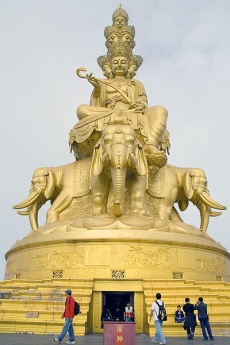Difference between revisions of "Bodhimanda"
| Line 1: | Line 1: | ||
| − | [[File:Puxian Emei.jpg|thumb|right|upright|Statue of the [[bodhisattva]] [[Samantabhadra]] at Mount Emei]] | + | [[File:Puxian Emei.jpg|thumb|right|upright|Statue of the [[bodhisattva]] [[Samantabhadra]] at [[Mount Emei]]]] |
| − | [[Bodhimaṇḍa]] ([[Sanskrit]] and [[Pali]]; [[traditional]] {{Wiki|Chinese}}: [[道場]]; pinyin: dàochǎng) is a term used in [[Buddhism]] meaning the "position of [[awakening]]." According to [[Haribhadra]], it is "a place used as a seat, where the [[essence]] of [[Enlightenment]] is present." Although spelled similarly, a [[Bodhimaṇḍa]] is not {{Wiki|synonymous}} with a [[Bodhimaṇḍala]], which is a "circle of [[Enlightenment]]." | + | [[Bodhimaṇḍa]] ([[Sanskrit]] and [[Pali]]; [[traditional]] {{Wiki|Chinese}}: [[道場]]; pinyin: [[dàochǎng]]) is a term used in [[Buddhism]] meaning the "position of [[awakening]]." According to [[Haribhadra]], it is "a place used as a seat, where the [[essence]] of [[Enlightenment]] is {{Wiki|present}}." Although spelled similarly, a [[Bodhimaṇḍa]] is not {{Wiki|synonymous}} with a [[Bodhimaṇḍala]], which is a "circle of [[Enlightenment]]." |
| − | Bodhimaṇḍas are regularly visited by [[Buddhist]] [[pilgrims]], and some have gone on to become popular secular tourist destinations as well. In many [[forms]] of [[Buddhism]], it is believed that bodhimaṇḍas are [[spiritually]] [[pure]] places, or otherwise conducive to [[meditation]] and [[Enlightenment]]. | + | [[Bodhimaṇḍas]] are regularly visited by [[Buddhist]] [[pilgrims]], and some have gone on to become popular {{Wiki|secular}} tourist destinations as well. In many [[forms]] of [[Buddhism]], it is believed that [[bodhimaṇḍas]] are [[spiritually]] [[pure]] places, or otherwise conducive to [[meditation]] and [[Enlightenment]]. |
| − | Different [[Buddhist]] sects often disagree on the location and significance of different bodhimaṇḍas. As one would expect, the southern [[Theravada]] [[tradition]] tends to emphasize the bodhimaṇḍas of the [[Indian]] subcontinent, while most northern [[Mahayana]] schools tend to venerate sites in [[China]], [[Japan]], and [[Tibet]]. | + | Different [[Buddhist]] sects often disagree on the location and significance of different [[bodhimaṇḍas]]. As one would expect, the southern [[Theravada]] [[tradition]] tends to {{Wiki|emphasize}} the [[bodhimaṇḍas]] of the [[Indian]] subcontinent, while most northern [[Mahayana]] schools tend to venerate sites in [[China]], [[Japan]], and [[Tibet]]. |
| − | ==Famous bodhimaṇḍas in India== | + | ==Famous [[bodhimaṇḍas]] in [[India]]== |
* [[Bodhgaya]]: [[Gautama Buddha]] | * [[Bodhgaya]]: [[Gautama Buddha]] | ||
* [[Mount Potalaka]]: [[Avalokiteśvara]] [[Bodhisattva]] | * [[Mount Potalaka]]: [[Avalokiteśvara]] [[Bodhisattva]] | ||
| − | ==Famous bodhimaṇḍas in China== | + | ==Famous bodhimaṇḍas in [[China]]== |
| − | * Mount Putuo: [[Avalokiteśvara]] [[Bodhisattva]] | + | * [[Mount Putuo]]: [[Avalokiteśvara]] [[Bodhisattva]] |
| − | * Mount Emei: [[Samantabhadra]] [[Bodhisattva]] | + | * [[Mount Emei]]: [[Samantabhadra]] [[Bodhisattva]] |
* [[Mount Wutai]]: [[Mañjuśrī]] [[Bodhisattva]] | * [[Mount Wutai]]: [[Mañjuśrī]] [[Bodhisattva]] | ||
* [[Mount Jiuhua]]: [[Kṣitigarbha]] [[Bodhisattva]] | * [[Mount Jiuhua]]: [[Kṣitigarbha]] [[Bodhisattva]] | ||
Revision as of 07:34, 27 January 2014
Bodhimaṇḍa (Sanskrit and Pali; traditional Chinese: 道場; pinyin: dàochǎng) is a term used in Buddhism meaning the "position of awakening." According to Haribhadra, it is "a place used as a seat, where the essence of Enlightenment is present." Although spelled similarly, a Bodhimaṇḍa is not synonymous with a Bodhimaṇḍala, which is a "circle of Enlightenment."
Bodhimaṇḍas are regularly visited by Buddhist pilgrims, and some have gone on to become popular secular tourist destinations as well. In many forms of Buddhism, it is believed that bodhimaṇḍas are spiritually pure places, or otherwise conducive to meditation and Enlightenment.
Different Buddhist sects often disagree on the location and significance of different bodhimaṇḍas. As one would expect, the southern Theravada tradition tends to emphasize the bodhimaṇḍas of the Indian subcontinent, while most northern Mahayana schools tend to venerate sites in China, Japan, and Tibet.
Famous bodhimaṇḍas in India
Famous bodhimaṇḍas in China
- Mount Putuo: Avalokiteśvara Bodhisattva
- Mount Emei: Samantabhadra Bodhisattva
- Mount Wutai: Mañjuśrī Bodhisattva
- Mount Jiuhua: Kṣitigarbha Bodhisattva
